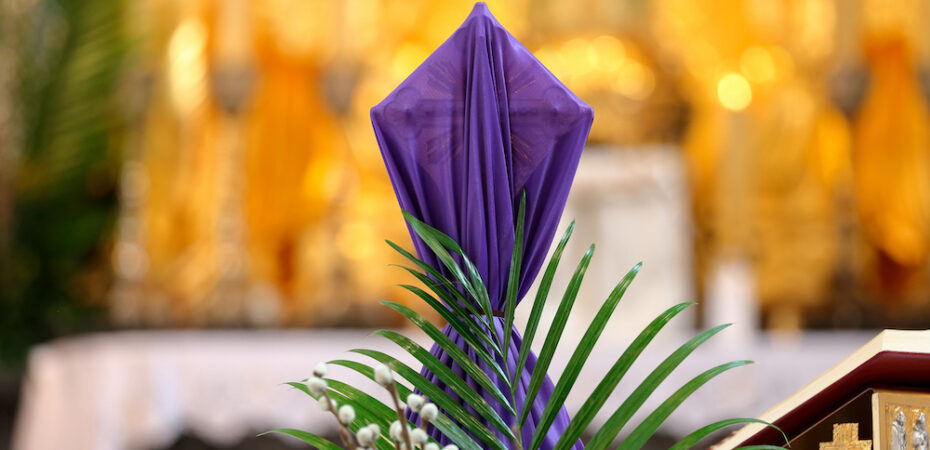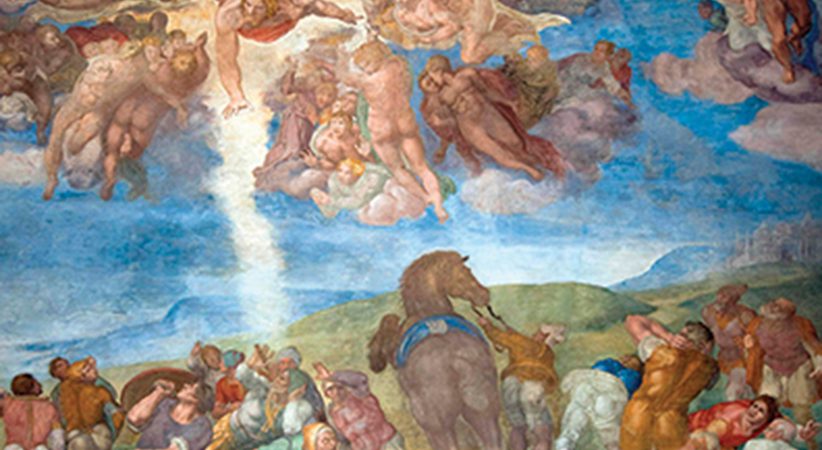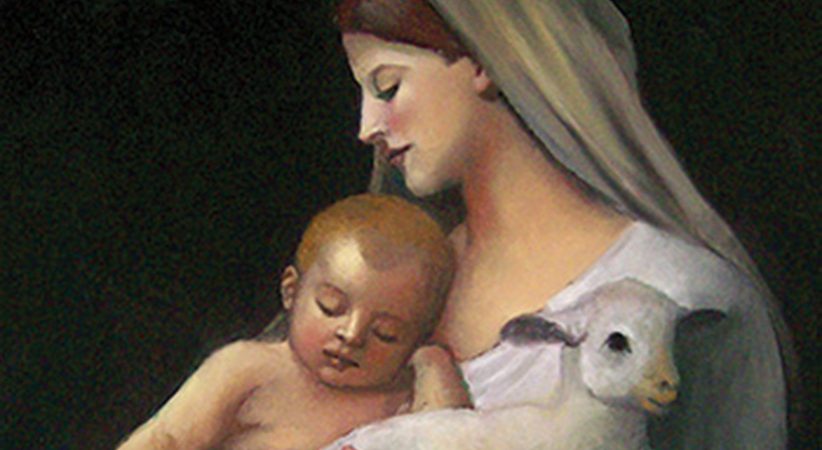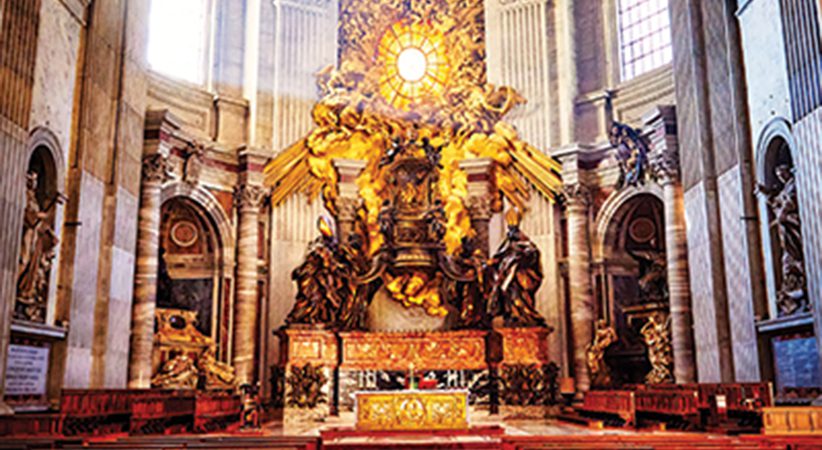Veiling of Statues in Holy Week
Highlighting an awareness that something is different as we prepare for the holiest time of the year
D.D. Emmons Comments Off on Veiling of Statues in Holy Week
Throughout the liturgical year, our holy Catholic Church provides us with a multitude of spiritual devotions and rituals, some of which are not considered obligatory. Unless otherwise specified by the bishop, the parish pastor can choose to observe, or not, the feet-washing ceremony on Holy Thursday, a Corpus Christi procession, the blessing of and procession with candles (Candlemas), Forty Hours devotion and others.
These expressive signs and actions were, for centuries, universally observed and still can help define us as Catholics; they motivate us in our faith journey and inspire us to draw nearer to God. Today, and for a variety of reasons, such rituals are not practiced everywhere. Another ritual that is not always observed is the traditional veiling of the church crucifixes and images during Lent.
Guidance regarding veiling of the images is found in the Third Edition of the Roman Missal: “In the Dioceses of the United States, the practice of covering crosses and images throughout the church from [the fifth] Sunday [of Lent] may be observed. Crosses remain covered until the end of the Celebration of the Lord’s Passion on Good Friday, but the images remain covered until the beginning of the Easter Vigil.”
This is a kind of visual fasting period — fasting from the sacred images such as the crucifix — that ends on Good Friday when we humbly venerate the wood of the cross. On Holy Saturday, our fast from seeing the other covered images ends at the Easter Vigil.
The Roman Missal also says in its instructions for the Mass of the Lord’s Supper that following the transfer of the Blessed Sacrament to the altar of repose on Holy Thursday: “At an appropriate time, the altar is stripped and, if possible, the crosses removed from the church. It is expedient that any crosses which remain in the church be veiled” (No. 41). Neither the Stations of the Cross nor stained-glass windows are included in the veiling. It is a longtime custom that crucifixes and images in our home also be covered. In addition to the Roman Missal, another source of information concerning veiling is found in the “Ceremonies of the Liturgical Year” (Ignatius Press, $19.95) by Bishop Peter J. Elliott.
While no specific cloth color is mandated when covering the crosses and images, purple is traditional; the color of penance and mourning remind us that this is a special time of penance, a time to seek out the Sacrament of Reconciliation, a time to rend our hearts and not our garments (cf. Jl 2:13). Although the entire season of Lent is dedicated to the Passion of Christ, the final two weeks are the most intense, and the covered images only increase the intensity.
Pastor’s Choice
Many pastors choose not to cover statues, crucifixes and images. There is a debate by some whether, during this part of Lent, all the images should be uncovered so we can reflect on them more devoutly, claiming that seeing the crucified Christ is more dramatic than seeing a covered crucifix. This argument led the bishops at the Second Vatican Council not to encourage covering the statues. However, bishops have not denied this ancient practice. If the pastor chooses to veil the crosses and images it can be quite impactful.
Anytime we walk into a church where all the images are hidden, it is a startling encounter, everything is different, our senses stirred. It is even more startling to the occasional or fallen-away Catholic who after an absence returns to Church during Lent and sees the images covered with purple shrouds, reminders of what Jesus suffered. They can’t help but be moved.
During Lent, commencing on Ash Wednesday, the Church begins taking away things from us; no meat on Fridays, the “A” word (Alleluia) is removed from the liturgy, the Gloria is not sung and, eventually, the bells are silenced, the decorations in the sanctuary have disappeared and beautiful images are covered. All these sacramentals are gone, albeit temporarily, as the Church calls us to focus on the Passion of Christ. There is a popular song of our time with lyrics that say: “Don’t know what you’ve got till it’s gone.” While the words were certainly not written in regard to the Passion of Christ, they are apropos when our sacramentals, our worship aids (that we often take for granted), are taken away.
Lenten Veil
In the early Church, penitents who had committed grave sin were not allowed to attend Mass and could not receive holy Communion until they had completed their penance, given absolution and granted permission to return to Mass by the bishop. During the Middle Ages, in the late-ninth or tenth centuries, the faithful mostly stopped going to holy Communion because they believed they were unworthy of such a divine gift. During that era, a veil, a Lenten veil, was draped in front of the sanctuary, so that during Mass, the sinful laity could not see what was taking place around the altar. So, in a sense, like the sinners of another era, their lack of holiness or their sinful ways kept them from participating in every aspect of the Mass. The majority of the people were illiterate at the time, and the cloth reminded them of the season and all its somberness. It also reminded the faithful of the veil that hung in the Jewish temple between the Holy Place and the Most Holy Place.
According to Donald Attwater, general editor of “A Catholic Dictionary” (TAN Books, $29.98), the Lenten veil was: “A curtain hung between the people and the altar during Lent in the Middle Ages, symbolizing the expulsion of sinners and penitents from the Church according to ancient discipline. Its color was at first white and afterwards purple. … It probably survives in the veiling of images during Passiontide.”
There is evidence that German churches of the Middle Ages placed a large veil or cloth before the altar so that the altar, altar cross and many statues were not visible to the laity. Known as the “hungertuch” (or hunger cloth), it hung before the altar from the beginning of Lent until Wednesday of Holy Week and was removed when the Gospel of Luke was read that included,: “Then the veil of the temple was torn down the middle” (Lk 23:45).
The Lenten veil eventually gave way to the covering of individual crosses, statues and images. In his book “Lent and Holy Week,” Jesuit Father Herbert Thurston explained this evolvement in Lent and Holy Week: “Just as all good Christian folk, by reception of ashes, were in a sense converted into penitents, so the exclusion from the church which was part of that discipline was represented by a sort of legal fiction, throughout which those who stood outside of the veil suspended across the chancel arch were regarded as figuratively outside the church. … It seems probable that the veiling of crosses and picture in Passiontide is a modification of this usage.”
Until the time of Vatican II, the last two weeks of Lent were known as Passiontide. Today, with the implementation of the revised liturgical calendar in 1969, Passiontide references Holy Week for Catholics throughout the Church, beginning with Palm Sunday of the Passion of the Lord.
Current Veiling Period
In our time, the period of covering statues and images begins with the Fifth Week of Lent, when, formerly, on that Sunday, the Gospel was from John 8:46-59. The Jews accused Jesus of being possessed by the devil and when he said, “‘Before Abraham came to be, I AM’ … they picked up stones to throw at him; but Jesus hid and went out of the temple area.” Jesus hid; in a like way, the covered crucifixes hide our Savior until the glory of uncovering the cross on Good Friday. Today, this Gospel from John 8 is read on Thursday, the Fifth Week of Lent.
On the days when crucifixes and images are covered, the Church is getting us ready for the holiest time of the year: the Triduum. In this somber atmosphere, the Church is expressing great sorrow and sadness over the ridicule, torture and death Our Lord endured. We know this story, and we long for the happy ending that comes on Easter morning when nothing is hidden.
D.D. EMMONS writes from Pennsylvania.
…………………………………………………………………………………………………………………………………………………
The Mystery of Passiontide
“The presentment of that awful hour leads the afflicted mother to veil the image of her Jesus. The statues of the saints, too are covered: for it is but just, that if the glory of the Master be eclipsed, the servant should not appear. The interpreters of the liturgy tell us that this ceremony of veiling the crucifix during Passiontide, expresses the humiliation, to which our Savior subjected himself, of hiding himself when the Jews threatened to stone him as is related to the Gospel of Passion Sunday. … Thus it is that, in those years when the Feast of our Lady’s Annunciation falls in Passion Week, the statue of Mary, the Mother of God remains veiled, even on that very day when the Archangel greets her as being full of grace and blessed among women.” — Abbott Dom Guéranger, OSB, “The Liturgical Year: Passiontide and Holy Week,” The Newman Press, 1949
…………………………………………………………………………………………………………………………………………………





